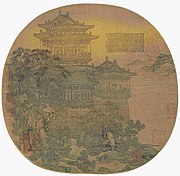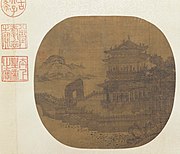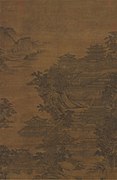User:Qiushufang/sandbox: Difference between revisions
Appearance
Content deleted Content added
Qiushufang (talk | contribs) |
drafts do not go in categories |
||
| Line 191: | Line 191: | ||
{{Song dynasty topics}} |
{{Song dynasty topics}} |
||
{{Religion in China}} |
{{Religion in China}} |
||
[[Category:Religion in China]] |
[[:Category:Religion in China]] |
||
[[Category:Tang dynasty| ]] |
[[:Category:Tang dynasty| ]] |
||
[[Category:Song dynasty]] |
[[:Category:Song dynasty]] |
||
Revision as of 05:31, 15 February 2021
Han
Tang
Li Zhaodao (675-758)
-
Luoyang Pavilion
-
Dragon boat race by Li Zhaodao (675-758)
Various
-
Li Sixun painting (651-716)
-
The Emperor's arrival at the summer palace Jiucheng by Li Sixun
-
A guard tower in Prince Yide's tomb mural
-
The Yueyang Tower by Li Sheng (fl. 908-925), Five Dynasties and Ten Kingdoms
-
Moung Kuanglu by Jing Hao (855-915)
-
A 10th-century mural painting in the Mogao Caves at Dunhuang showing monastic architecture from Mount Wutai, Tang dynasty
Song
Guo Zhongshu (929-977)
-
Summer Palace of Emperor Ming
-
Bringing a Lute to an Immortal's Pavilion
-
Riverside grain mill
-
Wangchuan villa
-
Wangchuan villa
Li Song (1190-1264)
Various
-
Streams and Mountains Under Fresh Snow by Gao Keming (1008-1053)
-
The Process of Making Silk by Liang Kai (12-13th c.)
-
Xiao Getting the Orchid Pavilion Scroll by Deception by Juran (960-)
-
A Solitary Temple Amid Clearing Peaks by Li Cheng(919–967)
-
Illustration to the Second Prose Poem on the Red Cliff by Qiao Zhongchang (960-1127)
-
Illustrations to six texts from the Xiaoya section of the Book of Songs by Ma Hezhi (12th c.)
-
Illustrations of the Classic of Filial Piety by Ma Hezhi (fl. 1131-1189)
-
Illustrations of the Classic of Filial Piety by Ma Hezhi (fl. 1131-1189)
-
Riverbank by Dong Yuan (c. 934 – c. 962)
-
A Palace by Zhao Boju (1120-1182)
-
Pure Summer at Liquan
-
Four Events from the Jingde Reign (1004-1007)
-
Burning Incense as an Offering by "Master" Li
-
Games in the Jinming Pool by Zhang Zeduan (1085–1145)
Yuan
Xia Yong (14th c.)
-
Fengle lou
-
Yingshui Loutai
-
Lü Dongbin passing Yueyang Tower
-
The Yellow Tower
Wang Zhenpeng (14th c.)
-
Dragon Baot Regatta by Wang Zhenpeng, 1310
-
Daming Palace, attributed to Wang Zhenpeng but likely 15th century production
Various
-
Spring Dawn Over Elixir Terrace by Lu Guang, Yuan dynasty
-
View of Immortal Mountain Tower by Lu Guang, Yuan dynasty
-
Han yuan tu by Li Rongjin, Yuan dynasty
-
Jianzhang Palace, Yuan dynasty
-
Mountain Villa by Sheng Mao (1310-1360)
-
Clearing After Sudden Snow by Huang Gongwang (1269–1354)
-
:Landscape with Pavilion, attributed to Sun Junze
-
'Landscape with Buildings' by Sun Junze, early 14th c.
-
Pavilion of Prince Teng by anonymous
-
Pavilion of Prince Teng by anonymous
-
Zhu Haogu's studio (14th century)
Ming
-
The Simple Retreat by Wang Meng (1308-1385)
-
Ming copy of Li Sixun's painting (651-716)
-
Ming copy of Emperor Ming (Emperor Xuanzong of Tang) goes to Shu by Li Sunxu (651-716)
-
The Yueyang tower during the Ming dynasty
-
Shanglin Park by Qiu Ying (1494-1552)
-
Han Palace Spring Daybreak by Qiu Ying
-
Viewing the Pass List by Qiu Ying
-
Fang zhao bo su hou chi bi by Wen Zhengming (1470-1559)
-
Morning Boat Jam by Yuan Shangtong (16th-17th c.)
-
Ming Emperor Xianzong Enjoying the Lantern Festival by Shang Xi, 1485
-
Mountain Hamlet Lofty Retreat by Li Zai (14-15th c.)
-
River Village in a Rainstorm by Lü-Wenying (c. 1500)
Along the River During the Qingming Festival
Religion in the Tang dynasty
Religion in the Tang dynasty (618-907) was primarily composed of three institutional religions: Confucianism, Taoism, and Buddhism, in addition to Chinese folk religion.
Religion in the Song dynasty
Religion in the Song dynasty (960–1279) was primarily composed of three institutional religions: Confucianism, Taoism, and Buddhism, in addition to Chinese folk religion.
Citations
Bibliography
- Ebrey, Patricia (1993), Religion and Society in T'ang and Sung China















































































